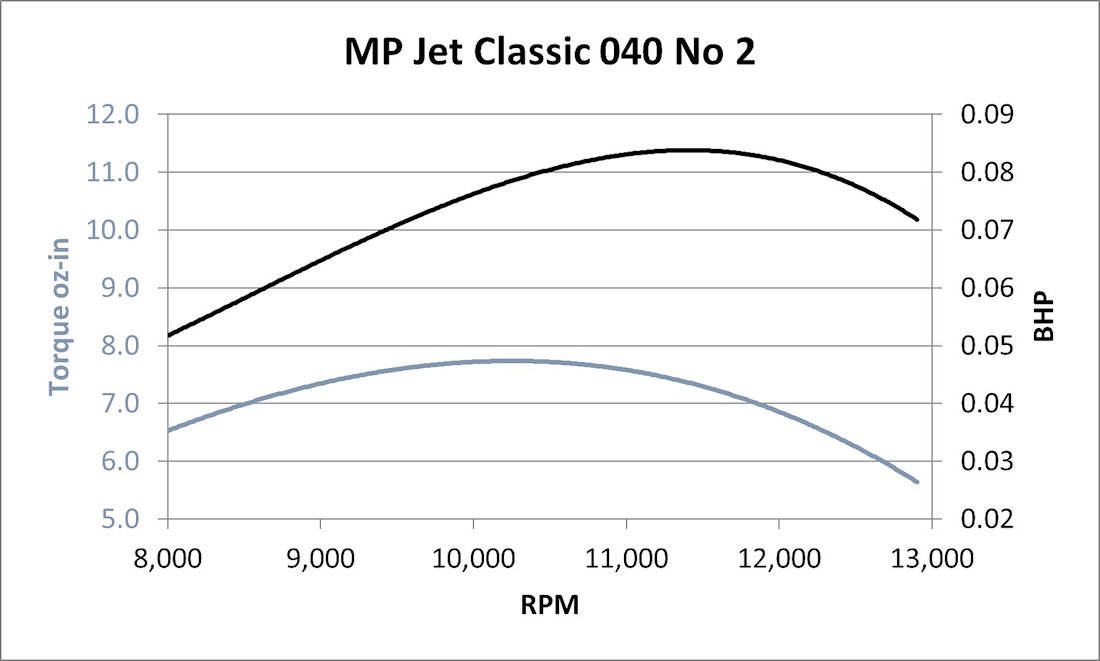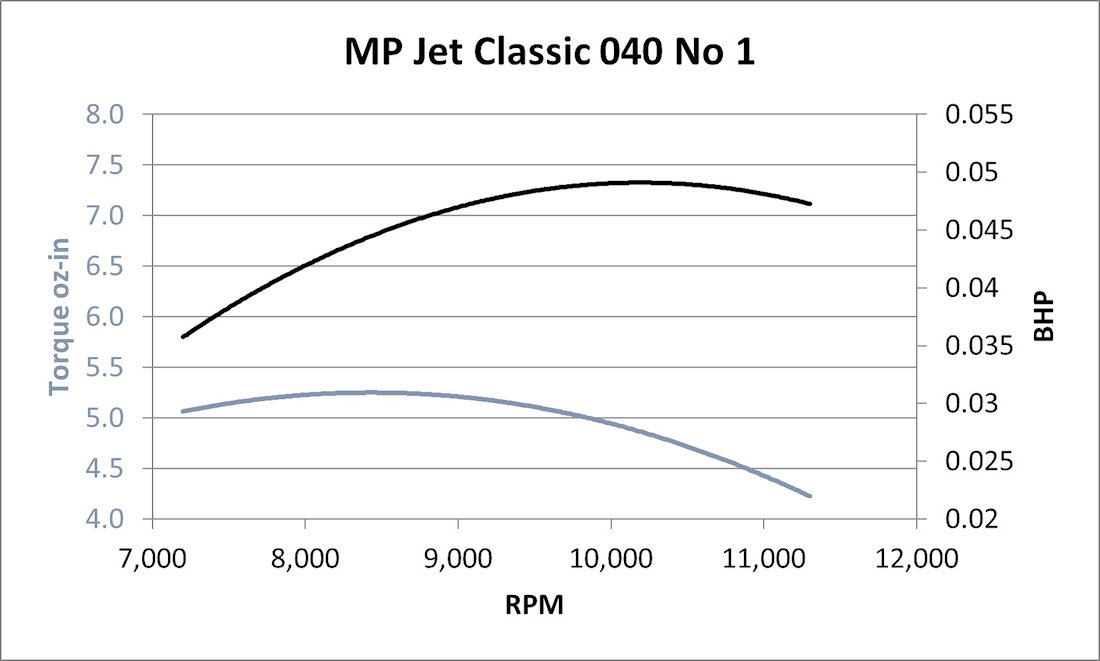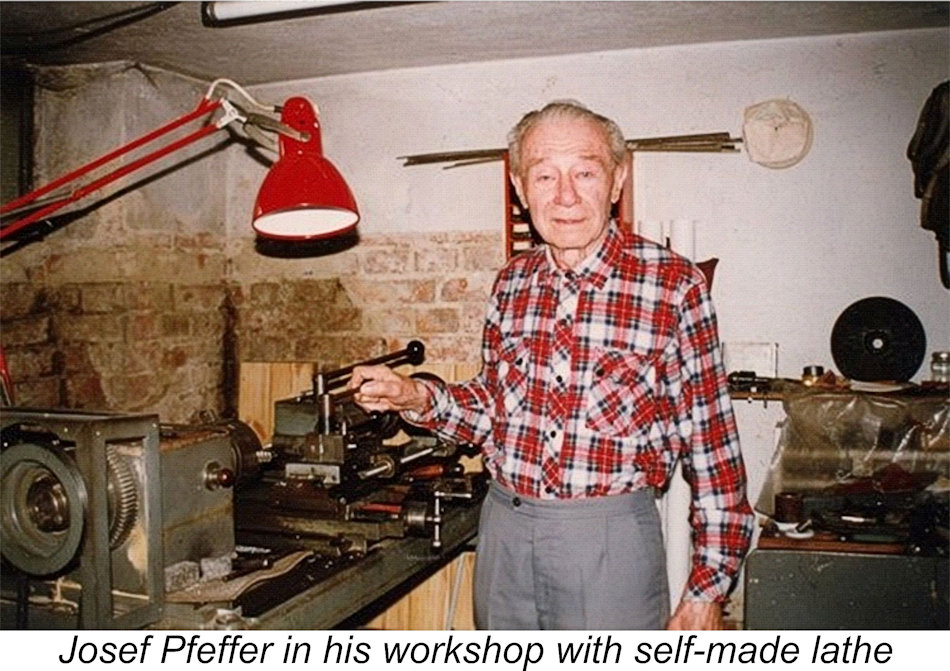
|
|
The Pfeffer 0.6 cc Diesels Josef Pfeffer of Brno, Czechoslovakia (now the Czech Republic) is one of the truly iconic designers and constructors of model engines worldwide. Born in 1911, he began designing and producing model engines in the early to mid-1940’s, continuing to do so until his death in the year 2000. Josef Pfeffer is perhaps best remembered for his series of 0.6 cc diesels which began appearing in 1948, initially under the LETMO trade-name. This was the trade-name used by Pfeffer’s fellow countryman Zdeněk Husička, which has led to some confusion regarding the identity of the designer of the LETMO MD-06, as this Pfeffer’s 0.6 cc designs are well-known and widely respected among latter-day model engine aficionados, particularly his "signature" designs featuring his trade-mark "square" heads like that seen here. However, they have not been particularly well documented in the English language up to now. I was given a priceless opportunity to rectify this situation thanks entirely to some splendid work on the part of my good mate Maris Dislers of Glandore, South Australia. Not only did Maris provide me with a draft English translation of an on-line Czech-language article on these engines, but he also undertook a hands-on review and test of a number of representative examples. The Czech article was written by Jaromír Pipek and mounted on the fascinating Czech-language KHMM.CZ (Historic Models & Motors Club) website. I contacted the Club and was delighted to receive permission to publish an edited English-language rendition of Mr. Pipek’s article on my own website. After reading Mr. Pipek’s very informative text, I came to the conclusion that his work and that undertaken by Maris belonged in the same overarching article. I judged it best to begin with Mr. Pipek’s account of the overall series, since this would provide some context for Maris’s reviews of a few representative examples. Accordingly, the following is our English translation of the account written by Jaromír Pipek covering the start-to-finish history of the Pfeffer 0.6 cc diesels. The Pfeffer 0.6 cc Engines By Jaromír Pipek
During the whole period of his modelling activities, Josef Pfeffer produced many dozens of model engines of various types and sizes, which were always characterized by perfect workmanship, high performance and reliability of operation. Some of them have literally become "legends" and are now much sought after by collectors of model engines around the world. The most famous and popular models are probably his small diesel engines of 0.6 cm3 swept volume which Mr. Pfeffer produced from 1948 onwards, some types in very small series.
The first few examples of the MD-0.6 engines in 1948 had a crankcase cast from a dark grey magnesium alloy, with an elektron cylinder jacket. Later examples from 1949 – 1950 had a crankcase cast from aluminium alloy and a cylinder jacket turned from duralumin. The MD-0.6 was a very successful engine and very popular among Czech modellers at that time. As a matter of interest, I would like to mention that in the 1990s the MP-JET company from České Budějovice produced very nice replicas of the MD-0.6 engine. Two limited series of 500 pieces were produced.
The intake was controlled by a rotary drum valve located in the rear section. The single rear exhaust port was equipped with a small duralumin silencer. Bore and stroke were both 9 mm for a displacement of 0.573 cm3. Only one engine was made, because it did not meet Mr. Pfeffer’s expectations and was also very demanding in terms of production. Another engine of 0.6 cm3 was also produced by Mr. Pfeffer in 1966 and may therefore be referred to as the Pfeffer 0.6/1966. This engine featured a completely different From 1969, Josef Pfeffer began to produce his best-known Pfeffer 0.6 engines with their trademark "square" finned cylinder jackets and heads. Building on the experience gained from previous types, he designed and produced a reliable, easy-starting engine in which he returned to the proven piston-controlled intake and reverse-flow scavenging with two side exhaust ports.
There are four basic types of Pfeffer 0.6 engines with the "square head", which differ mainly in the shape of the crankcase casting and the exhaust ports. In Mike Clanford’s British book entitled "A Pictorial A to Z of Vintage and Classic Model Airplane Engines" these individual The first type, the Pfeffer 0.6 Mk. I model produced beginning in 1969, had a crankcase casting featuring two square exhaust openings, without silencers. An example of this variant appears in the heading The next type, the Pfeffer 0.6 Mk. II, had the same crankcase casting as the Mk. I type, but now had two mufflers turned from duralumin which were glued to the exhaust holes on the crankcase with Loctite glue. The carburettor was amended to a peripheral-feed arrangement.
The Pfeffer 0.6 Mk. IV/B had a front section relieved by a recess on the front face. A plain crankshaft bearing continued to be used.
Some models (mainly the Mk. IV types) were also produced with a crankshaft mounted in 2 ball races. These units were designated as BB models. The enlarged cylindrical front section was identical for all examples, differing only in terms of minor modifications to the shape of The last examples of the Mk. IV/C and Mk. IV/C-BB variants from the 1990s were exclusively black-anodized, and in some of the very last examples the anodizing on the rounded corners was sanded away.
This completes a general overview of the 0.6 cc engines produced by Josef Pfeffer of Brno prior to his death in the year 2000. Given the fact that these engines were often produced to individual order, the author of the article does not guarantee the completeness of this overview of types or variants, because there of course may be (indeed, almost certainly are...) engines differing in certain details from the basic types described above. Pfeffer 0.6 Engines Manufactured by Miloslav Pokorný of Brno
These very interesting high-quality engines were produced in quite large numbers beginning in late 2000. However, in the autumn of 2011 Engineer Miloslav Pokorný unfortunately died, putting an end to their production. Jaromír Pipek Milevsko, Czech Republic January 16th, 2023 ________________________ Sincere thanks to Jaromír for sharing this information with us! The above account should have given you a good overview of the entire Pfeffer-designed 0.6 cc diesel series from start to finish. Fair enough – how do they perform? Good question, and one which my valued mate Maris Dislers was only too happy to answer! Over to Maris ………………. __________________________ The Pfeffer 0.6 cc Diesels Appraised By Maris Dislers LETMO MD-0.6 May as well begin at the beginning! Josef Pfeffer’s first model diesel engine of 1946 followed the Klemenz-Schenk DYNO-1’s core design elements and swept volume, but was entirely different in actual form. It featured typical Czech three-point radial mounting and a forward-facing venturi drawing from an annular fuel tank secured around the forward crankshaft section. In that respect, it resembled the first Atom 1.8 cc engines made by Vladislav Hruška.
We sampled its performance by testing a quite faithfully-replicated MP JET LETMO MD-0.6, circa 1998, with stronger forged connecting rod and improved needle valve design. The front crankcase section screws into the crankcase on a right-hand thread, which would originally have given no trouble, as clockwise propeller rotation (viewed from the front) was the norm in Eastern Europe at the time of the engine’s design. Friction and viscous drag loosened our front end when using regular propellers, necessitating thorough retightening. Mounting onto a suitable plywood former with inverted keyhole aperture and accommodating the propeller drive pin were other uncommon features. Full credit goes to MP JET for internal fits and finish. This one was a pleasure to operate, requiring minimal running-in time. We used a mix of equal parts ether, kerosene and SAE 50 mineral oil, plus 0.8% octyl nitrate ignition improver. Spot tests showed that the “dope” was not strictly necessary, although it did lower operating compression ratio for reduced load on the bearings. Vibration was notably low, especially considering that most running was done with the postcard-sized plywood mount simply held in one hand. The engine chugged away impressively with an oversize 8x6 propeller, showing no sign of stress. We didn’t explore the cited 12,000 RPM upper limit, as our tests indicated that the most usable performance came between 7,000 and 9,000 RPM. Maximum measured output was .045 BHP in the region of 8,000 to 9,000 RPM, with best torque of 5.7 oz-in either side of 7,500 RPM. The specific power output was equivalent to that of the contemporary Mills P.75.
Pfeffer 0.6 Mk. III Our test engine showed commendably precise fits and was seemingly ready to get on with the job. But after a short period of easy running, it would “go sour”, sounding “off” with reduced speed. This persisted despite further careful running, eventually demonstrating that something needed to be done. The culprit turned out to be a hot-running crankshaft bearing. It seems that Mr. Pfeffer’s precision fit provided no opportunity for lubricating oil to get in, apart from what oozed in between runs. I polished the crankshaft main journal (removing a scant 5 microns in diameter), but the real tonic was cutting a vertical groove into the crankcase face against which the crankweb bears (as per Cox .049's), creating a pathway for oil to reach the bearing. These measures cured the problem completely.
The other point is the engine's relatively generous 3.14 mm2 intake choke area. Coupled with the tangential fuel jet design, fuel suction is not so good at tick-over settings and with larger propellers. Once again, we used our equal parts ether/kerosene/mineral oil fuel with 0.8% ignition improver to good effect. Warm-up time was short and vibration was low at all speeds. Overall, a thoroughly likeable small diesel engine! The performance curves show a steady power increase, topping a peak output of .06 BHP at around 11,000 RPM, while torque remains essentially flat up to its maximum 6 oz-in at around 9,500 RPM. Both torque and power decline quite rapidly at higher speeds. Allan Laycock reports that a Cox 7x3½ propeller works well, allowing the engine to work in its optimum 10,000 - 11,000 RPM zone in flight.
0.6cc Mini-DYNO
Our particular mini DYNO 0.6cc was perhaps made by someone else (possibly Miloslav Pokorný?!?), as its crankcase is a different casting to the known Pfeffer mini-DYNO and the design of the small components is not quite the same. No fuel tank either, so we made our own. Yet our example is probably a functional equivalent, suitable for assessing performance.
In practical terms, an 8x5 or 8x4 propeller would provide useful thrust, as the engine is much happier operating close to its maximum torque level than chasing top power output. If nothing else, an eight-inch propeller looks more in proportion to the engine’s bulk, while the extra flywheel effect improves starting and the slower speed matches its first-generation heritage. Finger choking was not very effective, as the symmetrical intake timing could simply blow fuel drawn into the unusually short venturi tube straight out on the downstroke. Better to shoot a little fuel into the intake tube using a syringe and draw that in (at least mostly) to prime the crankcase. Using this approach, starting was easy. Needle response was somewhat vague, yet quite exacting to gain the last few hundred RPM. By contrast, compression adjustment was positive and predictable. The engine could be backed off to a satisfying tick-over. Fuel consumption was proportional to its modest power output. Incidentally, our test fuel of equal parts ether, kerosene and SAE 50 mineral oil, plus 0.8% ignition improver delivered an additional 300 to 600 RPM (depending on the propeller) against an equivalent formula with castor oil as the lubricant.
MP Jet Classic 040 This one is described as being "inspired" by engines from the 1940’s. Although neither the designer nor the extent of any involvement by Josef Pfeffer are known, the Classic bears more than a passing resemblance to the LETMO MD-0.6. For the sake of perspective, we added it to this review. Substantial differences are its taller and bulkier monobloc crankcase with beam mounting lugs and screw-in carburettor/tank assembly. The crankshaft features a normal crank disc, unlike the MD-0.6’s dogleg style. Other internal differences were not examined.
We present two sets of results from our own tests. Engine no. 1 was still a little on the tight side, but gave results around the same as the published reviews and not so different from the LETMO MD-0.6, apart from doing its best work in the 8500 – 10,000 RPM bracket. Engine no. 2 was well and truly run in, being destined for our local SAM KeilKraft Champ Proto Speed competitions. It remains completely standard apart from having the fuel metering jet lowered so that it sits flush with the bottom edge of the intake tube. This gives an additional 50% effective choke area, for substantially higher torque and power output. At the time of writing, it still held the record in this Class, ahead of all other side-port engines up to 0.8 cc swept volume. When fitted with an after-market R/C throttle, it recorded; APC 7x3 - 11,400 RPM, APC 7x4 - 10,300 RPM, APC 8x4 - 8,400 RPM. Peter Chinn might have said “this could be a particularly good one, and certainly is in modified form, but does demonstrate the design’s potential”.
The relative weights and major external dimensions of the tested engines are given in the following table.
Maris Dislers, Glandore, South Australia March 2023 __________________________ Well, there you have it! You now know a great deal more than you did before about one of the most enduring and endearing model engine designs of the classic era. My very sincere thanks to both authors - it was my privilege to present this information for your enjoyment. These engines are a testament to the enthusiasm, talent and skill of their designer, Mr. Josef Pfeffer. Long may they keep running!
_________________________ Article first published on this website June 2023 |
||||
| |
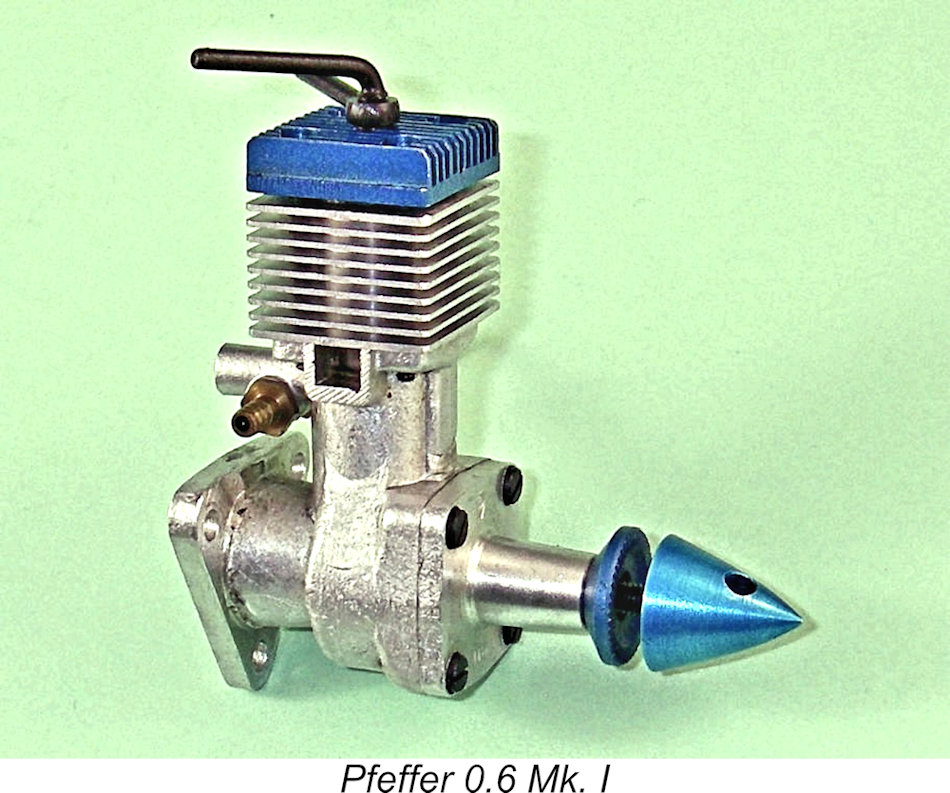 original model was named. The designer was definitely Josef Pfeffer, and his work with 0.6 cc diesels continued more or less right up to his death. After that unhappy event, his efforts were carried on by his close friend and associate Miloslav Pokorný of Brno, only ceasing with the death of Pokorný in 2011.
original model was named. The designer was definitely Josef Pfeffer, and his work with 0.6 cc diesels continued more or less right up to his death. After that unhappy event, his efforts were carried on by his close friend and associate Miloslav Pokorný of Brno, only ceasing with the death of Pokorný in 2011.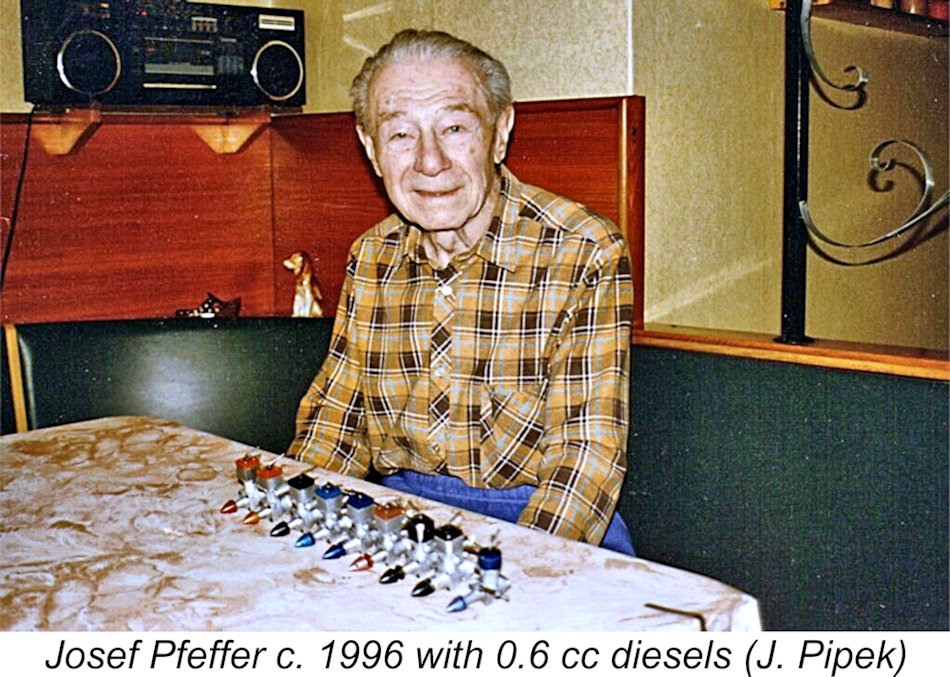 The famous modeller Mr. Josef Pfeffer from Brno (born in 1911 and died 7.11.2000) is renowned for producing model engines of his own design, which he constructed beginning in the early 1940’s.
The famous modeller Mr. Josef Pfeffer from Brno (born in 1911 and died 7.11.2000) is renowned for producing model engines of his own design, which he constructed beginning in the early 1940’s.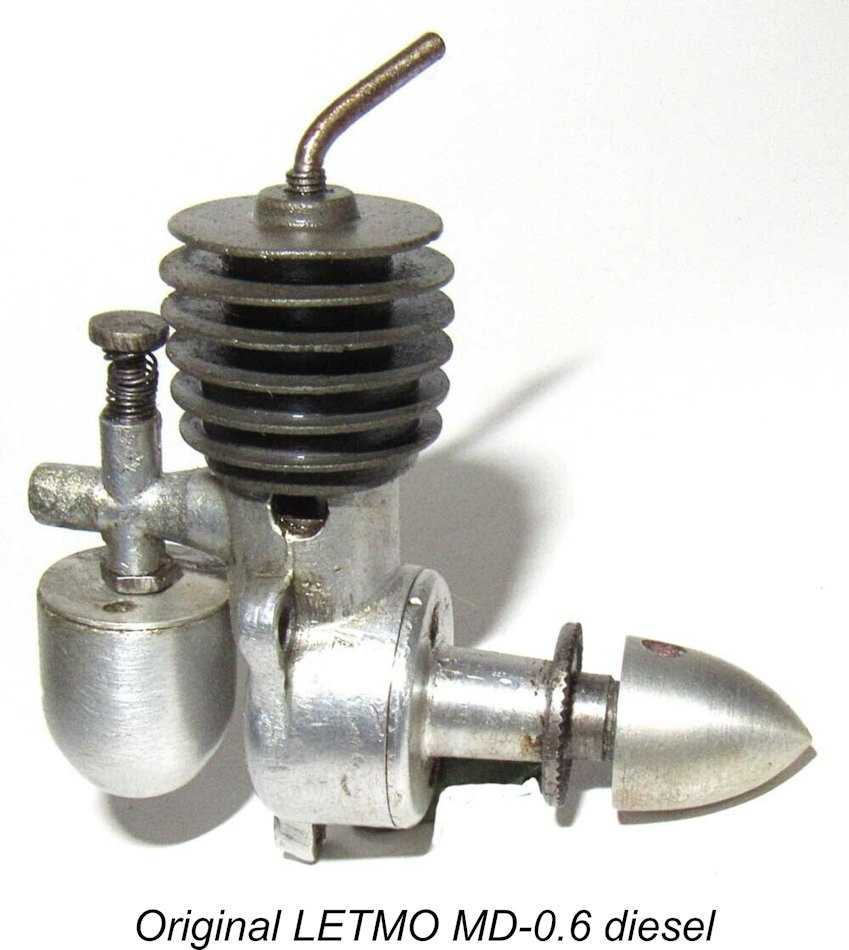 His first 0.6 cm
His first 0.6 cm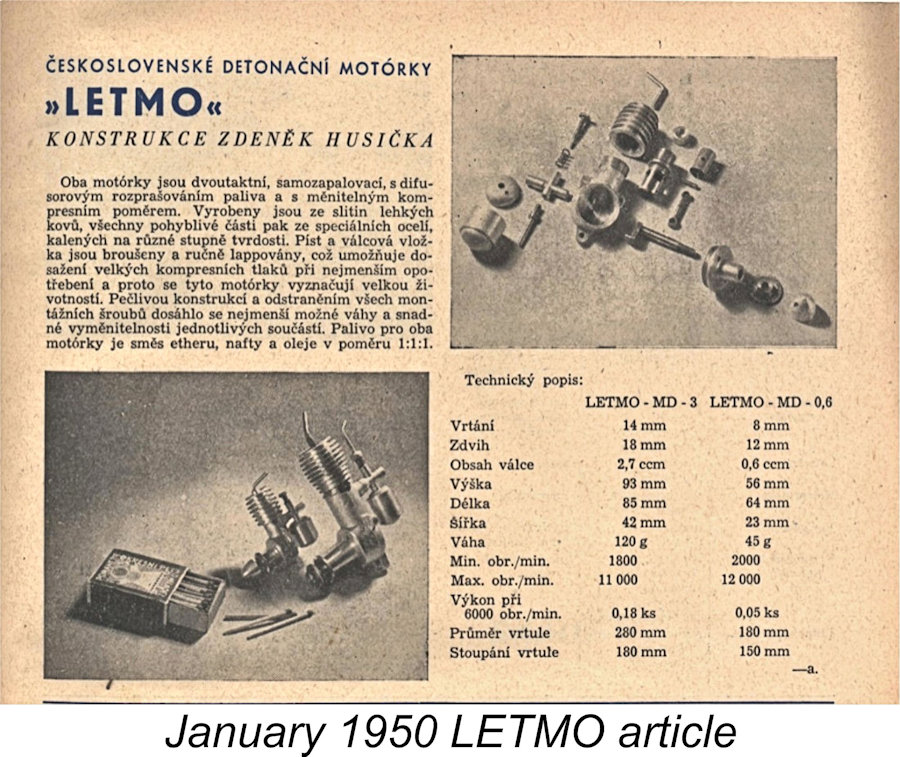 The engine had a bore of 8 mm and a stroke of 12 mm for a displacement of 0.603 cm
The engine had a bore of 8 mm and a stroke of 12 mm for a displacement of 0.603 cm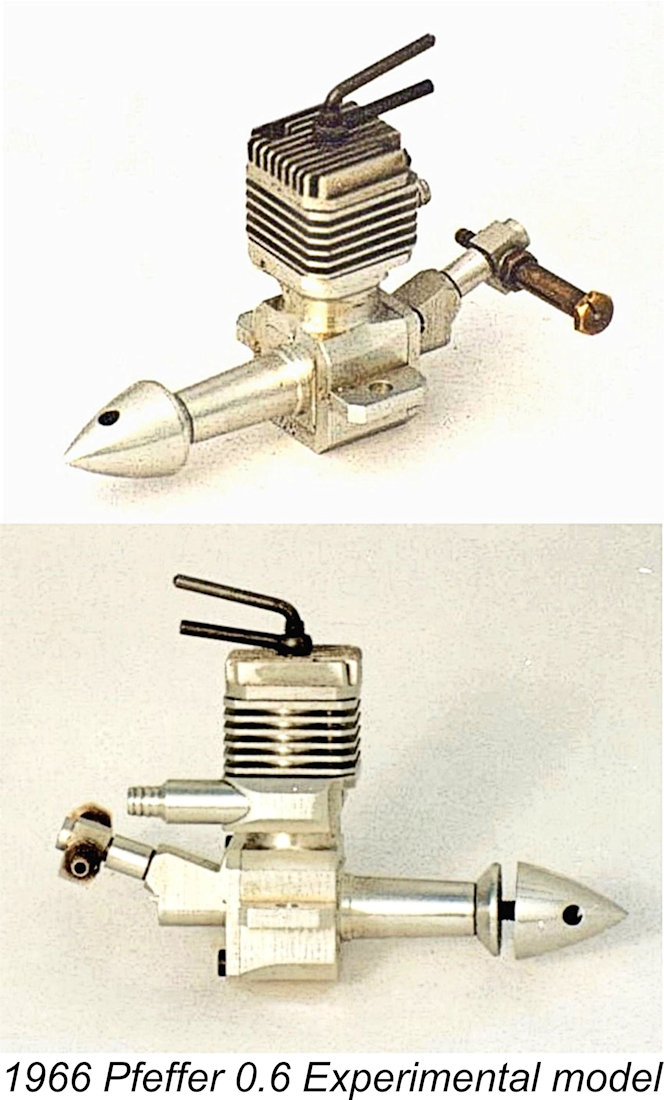 Other engines with a displacement of 0.6 cm
Other engines with a displacement of 0.6 cm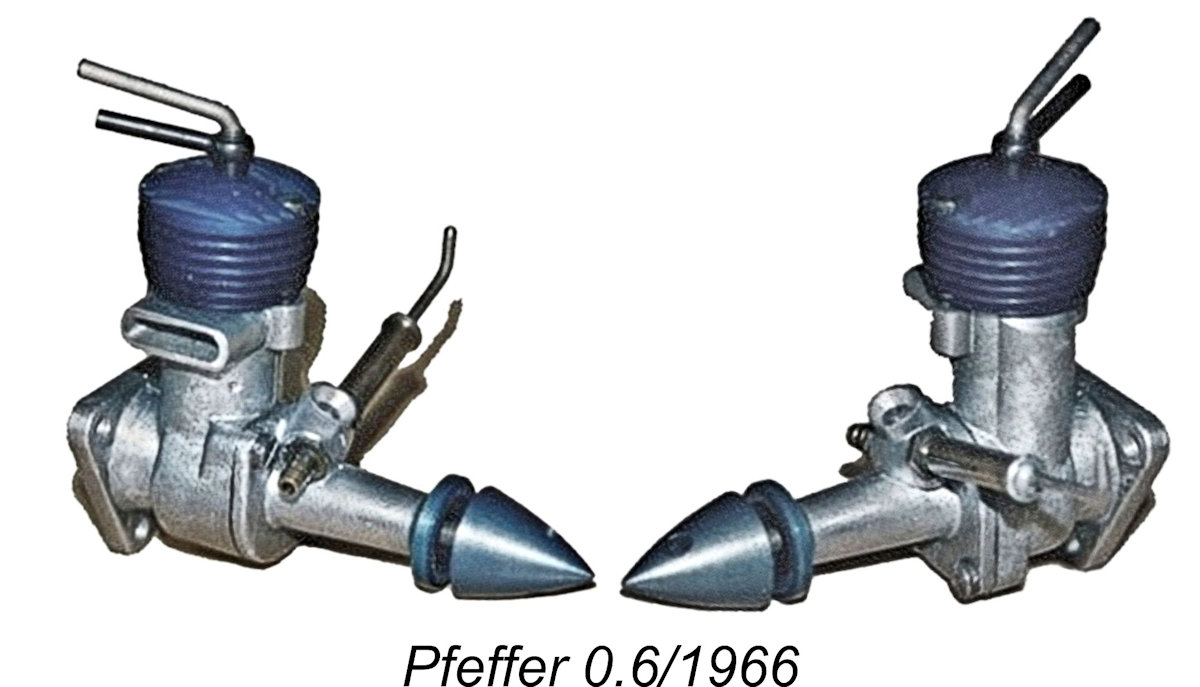
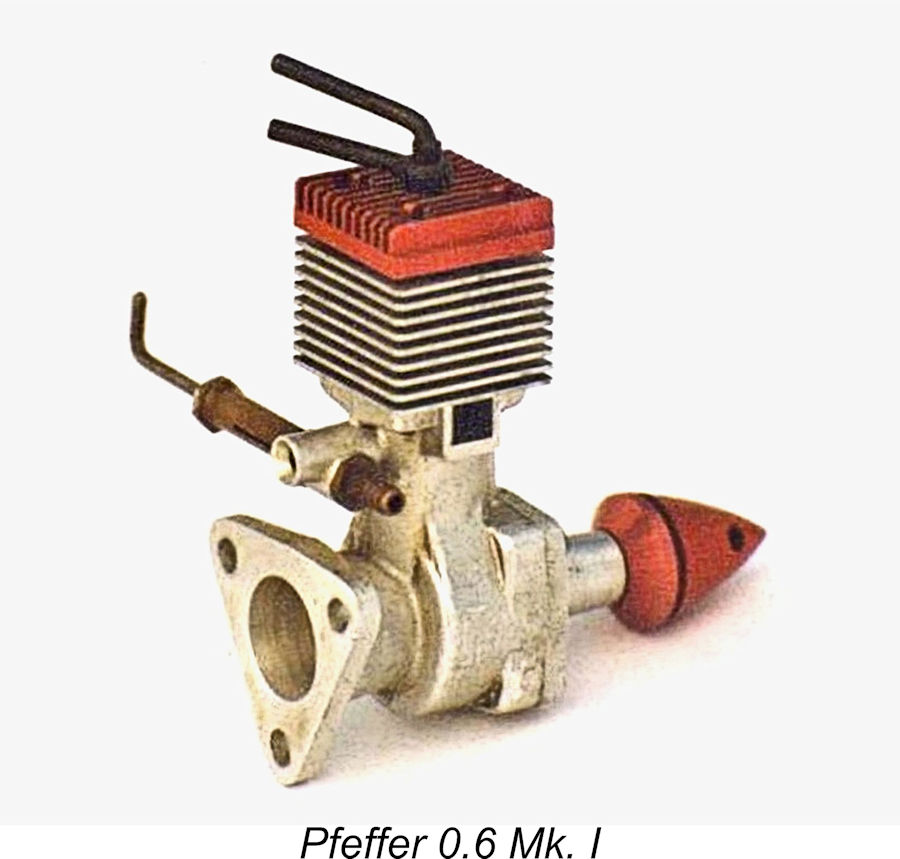 The crankcase of this engine was cast from aluminium alloy, with an integral triangular mounting flange located at the rear. The removable front section was attached with 4 short M2 screws. The "square" finned cooling jacket of the cylinder and the finned cylinder head of a matching square shape were milled from duralumin and were attached to the crankcase by four long M2 screws. Bore and stroke remained 8/12 mm. These Pfeffer 0.6 engines were to remain in limited production in small series with various minor changes until 1996.
The crankcase of this engine was cast from aluminium alloy, with an integral triangular mounting flange located at the rear. The removable front section was attached with 4 short M2 screws. The "square" finned cooling jacket of the cylinder and the finned cylinder head of a matching square shape were milled from duralumin and were attached to the crankcase by four long M2 screws. Bore and stroke remained 8/12 mm. These Pfeffer 0.6 engines were to remain in limited production in small series with various minor changes until 1996. 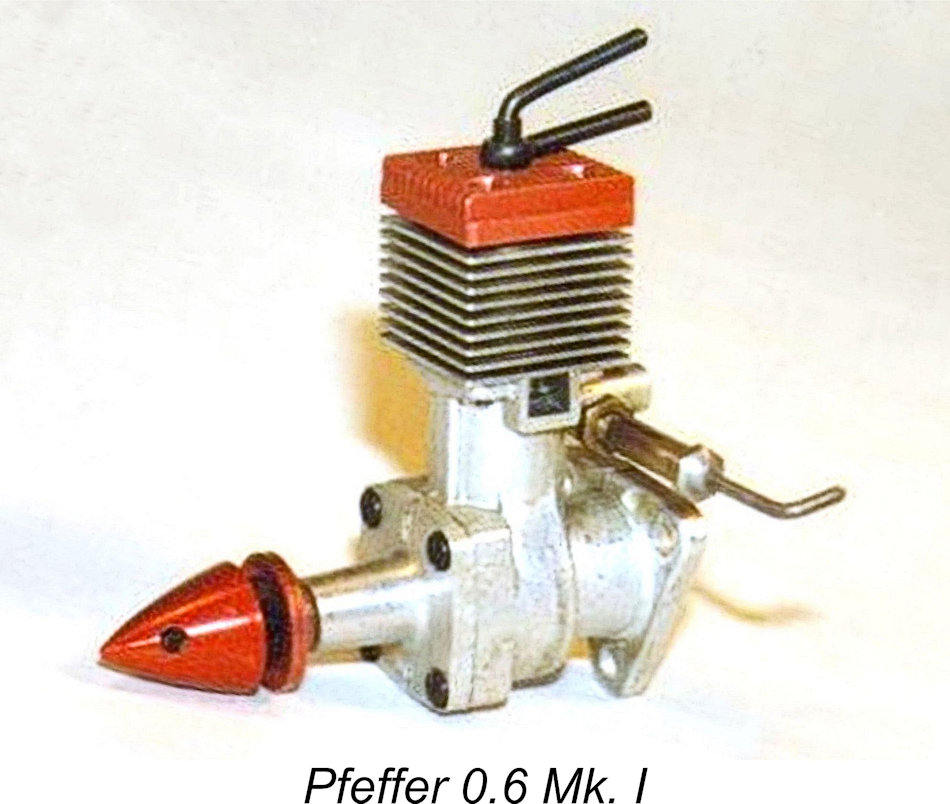 types were designated as Mk. I to Mk. IV. This designation is now in common use among collectors of model engines around the world, so we will continue to use it for clarity, although the manufacturer himself did not distinguish the individual types numerically.
types were designated as Mk. I to Mk. IV. This designation is now in common use among collectors of model engines around the world, so we will continue to use it for clarity, although the manufacturer himself did not distinguish the individual types numerically. 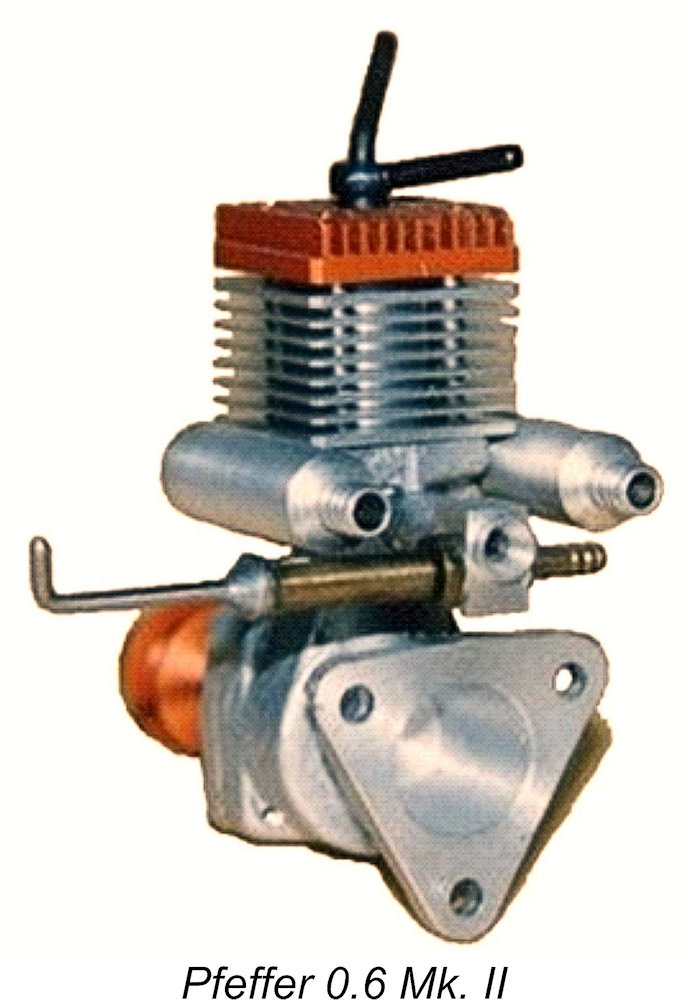
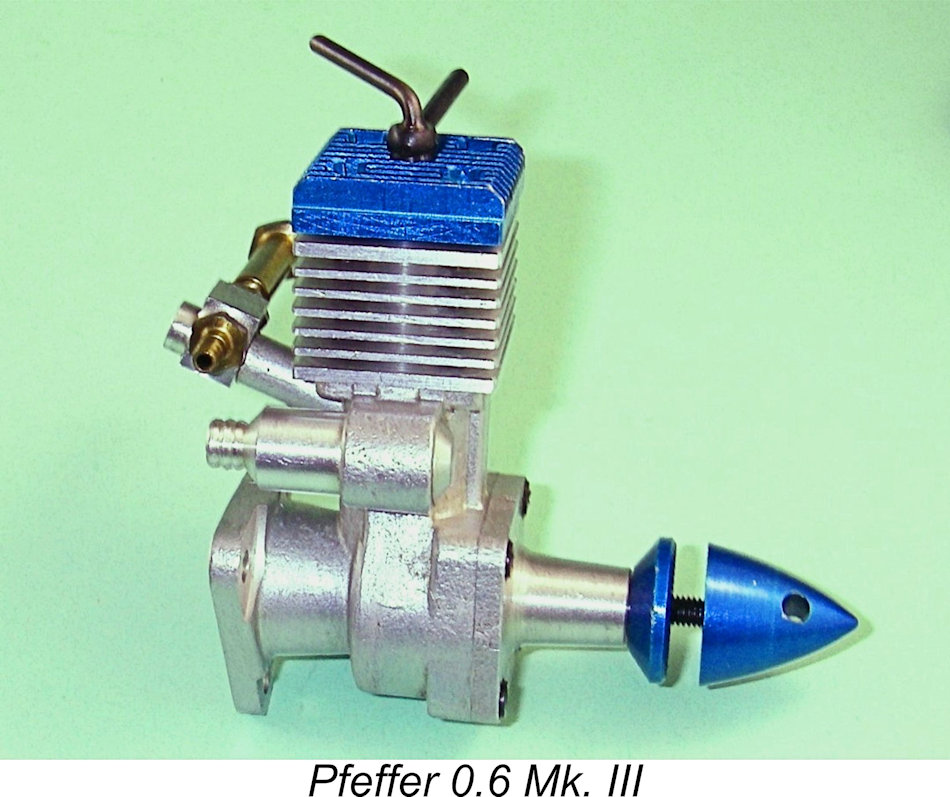 For the Pfeffer 0.6 Mk. III type, a modified crankcase casting was used for the first time, with two side exhaust “bulges” into which small cylindrical mufflers turned from duralumin were pressed in from the front. This model had side bulges of a "semicircular" shape which accommodated 7.5 mm diameter mufflers. Another modification to the crankcase casting consisted of changing the shape and alignment of the intake venturi, which was now angled upwards to position the carburettor needle above the mufflers, which extended to the rear behind the engine.
For the Pfeffer 0.6 Mk. III type, a modified crankcase casting was used for the first time, with two side exhaust “bulges” into which small cylindrical mufflers turned from duralumin were pressed in from the front. This model had side bulges of a "semicircular" shape which accommodated 7.5 mm diameter mufflers. Another modification to the crankcase casting consisted of changing the shape and alignment of the intake venturi, which was now angled upwards to position the carburettor needle above the mufflers, which extended to the rear behind the engine. 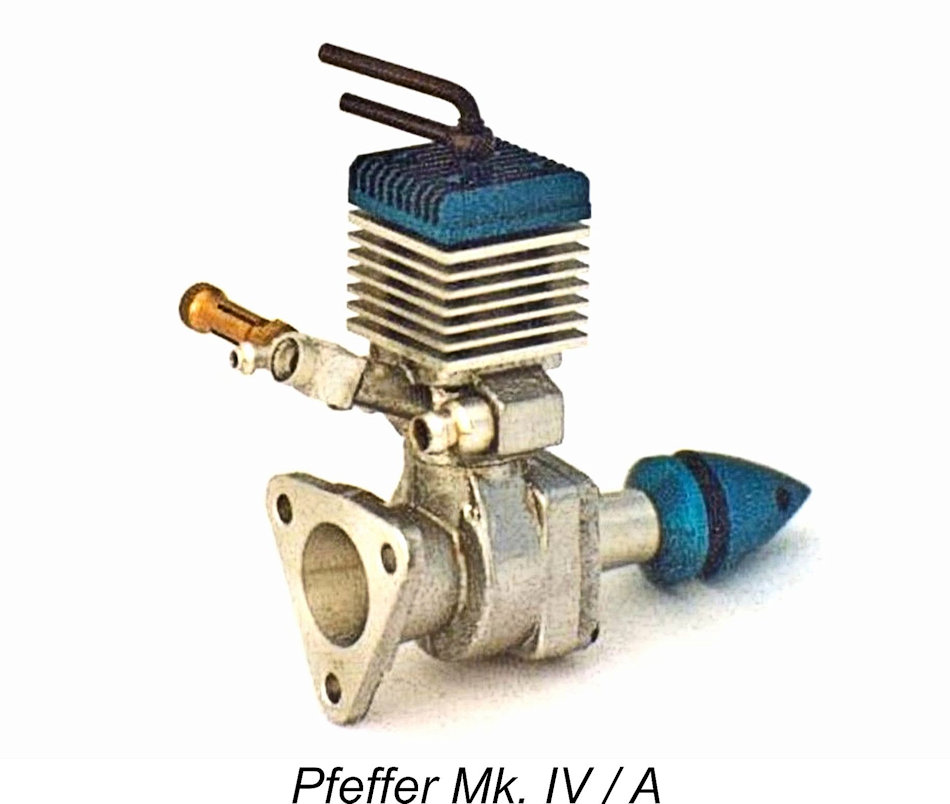 This was followed by the Pfeffer 0.6 Mk. IV, which is one of the most widespread types of this engine. The Mk. IV was produced successively in several versions, which however always have the same basic crankcase casting. The side bulges for the mufflers were "squared off" at the outer edges, while the muffler diameter was reduced to 6 mm from the original 7.5 mm. The carburettor design was also amended once again to utilize a banjo fuel supply fitting. Individual versions of the Mk. IV type differ in the design of the front section as well as the shape of the finned cylinder jacket and cylinder head. For greater clarity, we identify the major variants with a "slash" A, B and C.
This was followed by the Pfeffer 0.6 Mk. IV, which is one of the most widespread types of this engine. The Mk. IV was produced successively in several versions, which however always have the same basic crankcase casting. The side bulges for the mufflers were "squared off" at the outer edges, while the muffler diameter was reduced to 6 mm from the original 7.5 mm. The carburettor design was also amended once again to utilize a banjo fuel supply fitting. Individual versions of the Mk. IV type differ in the design of the front section as well as the shape of the finned cylinder jacket and cylinder head. For greater clarity, we identify the major variants with a "slash" A, B and C. 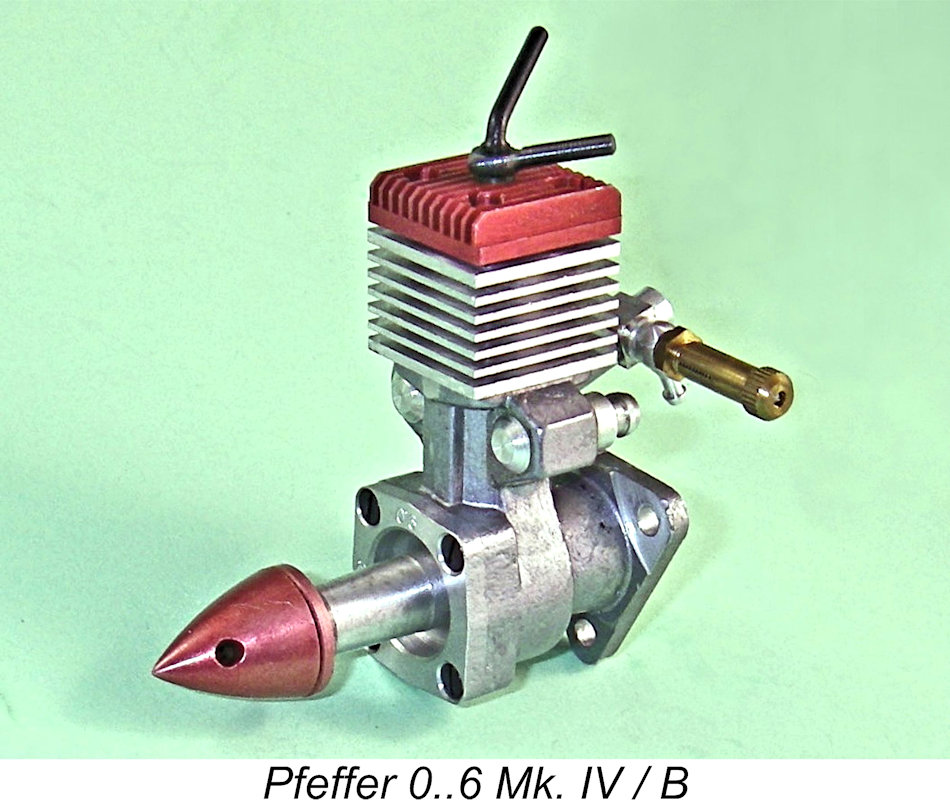 The Pfeffer 0.6 Mk. IV/A variant had a front section identical to the Mk. I to Mk. III types, without a relief recess on the front face and with a plain crankshaft bearing.
The Pfeffer 0.6 Mk. IV/A variant had a front section identical to the Mk. I to Mk. III types, without a relief recess on the front face and with a plain crankshaft bearing. 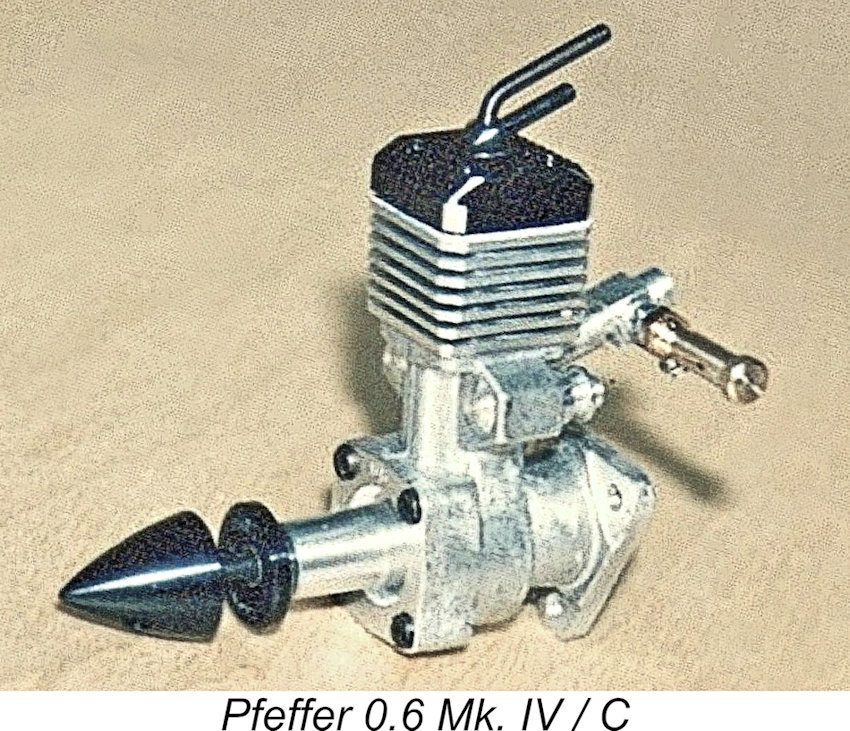 The Pfeffer 0.6 Mk. IV/C had a front section lightened by a recess like type Mk. IV/B, but the finned cylinder jacket and head had "rounded" corners. A plain bearing continued to be featured.
The Pfeffer 0.6 Mk. IV/C had a front section lightened by a recess like type Mk. IV/B, but the finned cylinder jacket and head had "rounded" corners. A plain bearing continued to be featured. 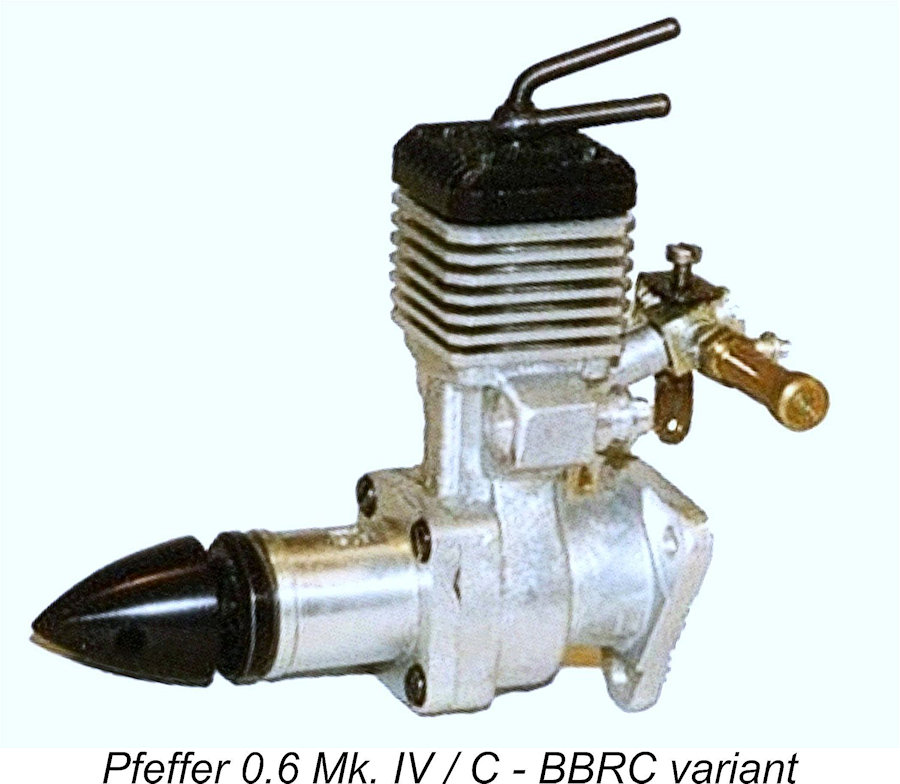 the prop driver. The engines were also supplied with a simple R/C carburettor in place of a standard carburettor – these were designated as BB/RC models. These R/C carburettors could be mounted on plain bearing types, but were recommended by the manufacturer specifically only for BB versions. These engines were almost certainly the smallest R/C diesels ever produced.
the prop driver. The engines were also supplied with a simple R/C carburettor in place of a standard carburettor – these were designated as BB/RC models. These R/C carburettors could be mounted on plain bearing types, but were recommended by the manufacturer specifically only for BB versions. These engines were almost certainly the smallest R/C diesels ever produced. 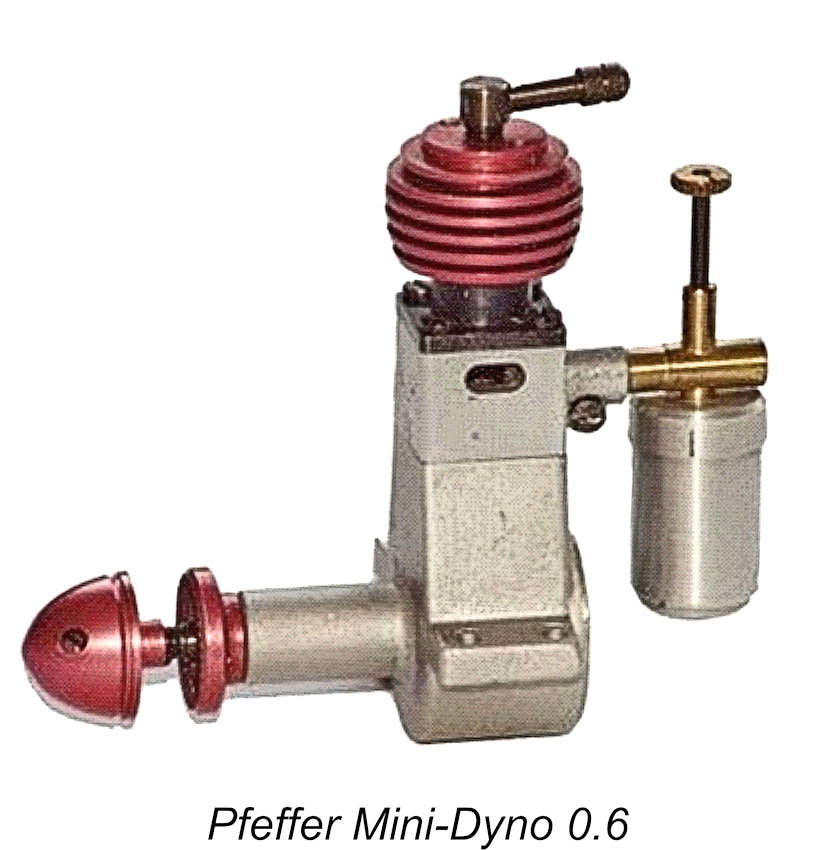 Josef Pfeffer's "classic range" of 0.6 cc engines just described is somewhat different from his miniature replica of the world's first widely-distributed commercial diesel engine, the Swiss DYNO-I engine from 1941, which he produced as the Pfeffer DYNO-0.6. In the years 1994-1995 he produced several dozen examples of this engine, mainly for the Swedish engine dealer Arne Hende. Accordingly, most of them have A.H. 0.6 embossed on the front of the crankcase. These engines usually had an anodized screwed-on finned cylinder jacket, propeller driver and spinner nut - the colours were blue, magenta and black. The DYNO 0.6 replica was also supplied with an optional R/C carburettor.
Josef Pfeffer's "classic range" of 0.6 cc engines just described is somewhat different from his miniature replica of the world's first widely-distributed commercial diesel engine, the Swiss DYNO-I engine from 1941, which he produced as the Pfeffer DYNO-0.6. In the years 1994-1995 he produced several dozen examples of this engine, mainly for the Swedish engine dealer Arne Hende. Accordingly, most of them have A.H. 0.6 embossed on the front of the crankcase. These engines usually had an anodized screwed-on finned cylinder jacket, propeller driver and spinner nut - the colours were blue, magenta and black. The DYNO 0.6 replica was also supplied with an optional R/C carburettor. 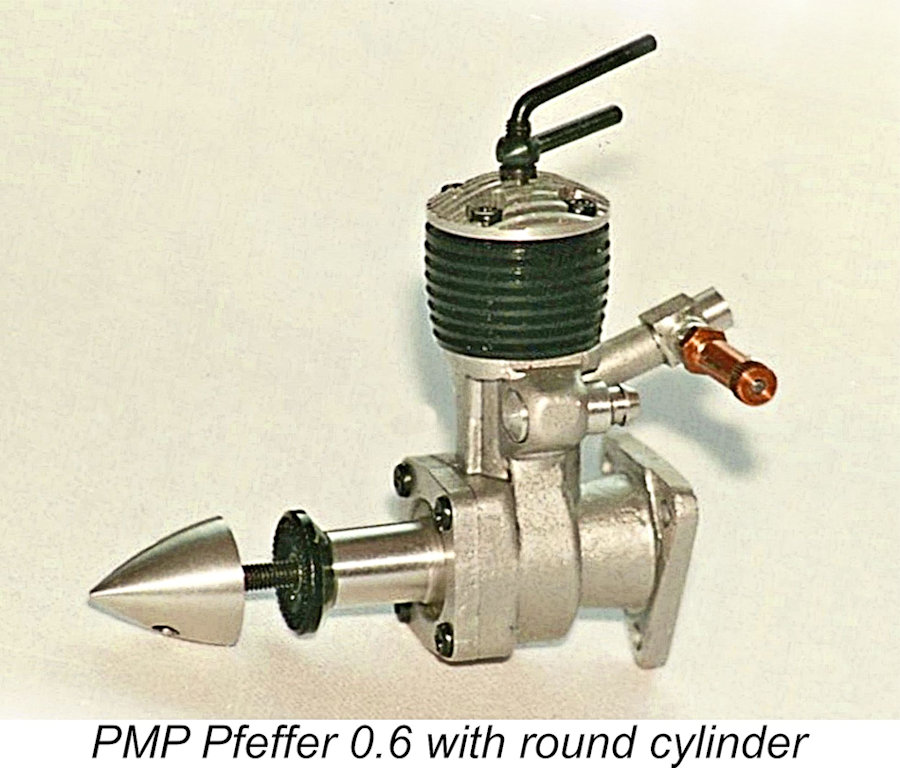 After the death of Mr. Josef Pfeffer in the year 2000, the production of Pfeffer 0.6 engines (and some other types of various specifications) was continued by his long-time friend Miloslav Pokorný of Brno, who had always worked closely with him on the production of his engines. Mr. Pokorný marked the Pfeffer engines of his own production with a stylized PMP logo, which stood for PFEFFER – MOTORS – POKORNÝ. This logo is reproduced below at the left.
After the death of Mr. Josef Pfeffer in the year 2000, the production of Pfeffer 0.6 engines (and some other types of various specifications) was continued by his long-time friend Miloslav Pokorný of Brno, who had always worked closely with him on the production of his engines. Mr. Pokorný marked the Pfeffer engines of his own production with a stylized PMP logo, which stood for PFEFFER – MOTORS – POKORNÝ. This logo is reproduced below at the left.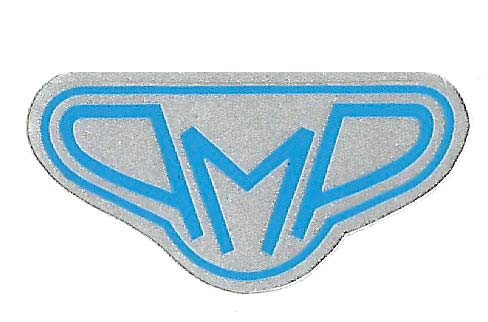 In addition to the classic “square" Pfeffer designs of the 0.6 cc Mk. IV type and replicas of the DYNO 0.6 engines, Mr. Pokorný later produced his own slightly modified PMP 0.6 models with a "round" head. Accordingly, "zero-sixes" of various arrangements were created, with plain or ball bearing crankshaft bearings (PB meant plain bearing and BB ball bearings); various mountings for attaching small side mufflers; different colours of anodized parts; and different carburettors.
In addition to the classic “square" Pfeffer designs of the 0.6 cc Mk. IV type and replicas of the DYNO 0.6 engines, Mr. Pokorný later produced his own slightly modified PMP 0.6 models with a "round" head. Accordingly, "zero-sixes" of various arrangements were created, with plain or ball bearing crankshaft bearings (PB meant plain bearing and BB ball bearings); various mountings for attaching small side mufflers; different colours of anodized parts; and different carburettors. 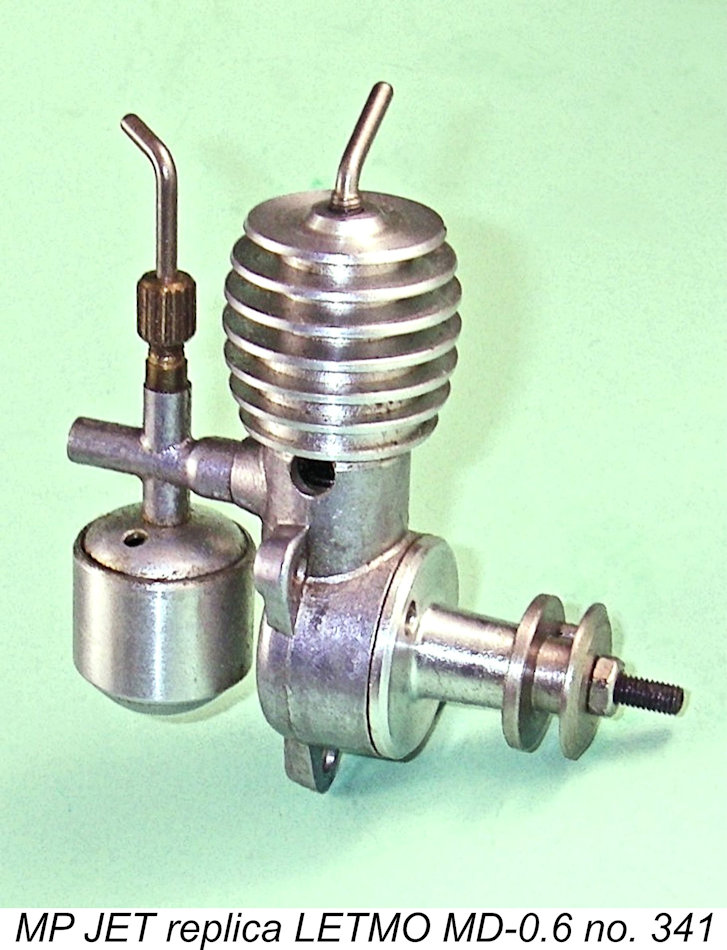 The more conventional (rear side-port intake with suspended fuel tank) 2.7 cc LETMO MD followed in 1947, being the prototype for the production MD-3 engine. In 1948 Zdeněk Huzička successfully competed in Poland with a smaller derivative. This unit was put into limited production by Josef Pfeffer during 1949 – 1950 as the LETMO MD-0.6, as discussed above by Jaromír Pipek. It was rated at a power output of 0.04 KW (0.054 BHP) with a maximum 12,000 RPM operating speed.
The more conventional (rear side-port intake with suspended fuel tank) 2.7 cc LETMO MD followed in 1947, being the prototype for the production MD-3 engine. In 1948 Zdeněk Huzička successfully competed in Poland with a smaller derivative. This unit was put into limited production by Josef Pfeffer during 1949 – 1950 as the LETMO MD-0.6, as discussed above by Jaromír Pipek. It was rated at a power output of 0.04 KW (0.054 BHP) with a maximum 12,000 RPM operating speed.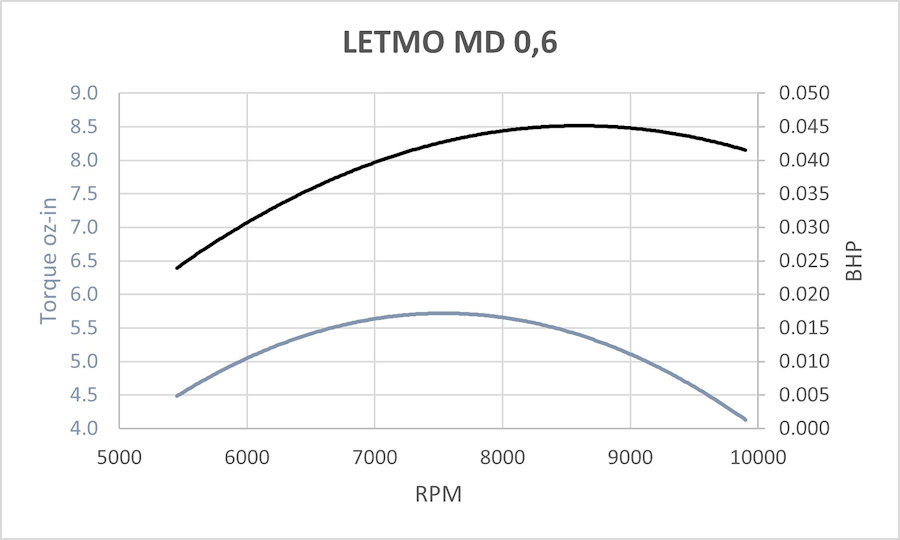
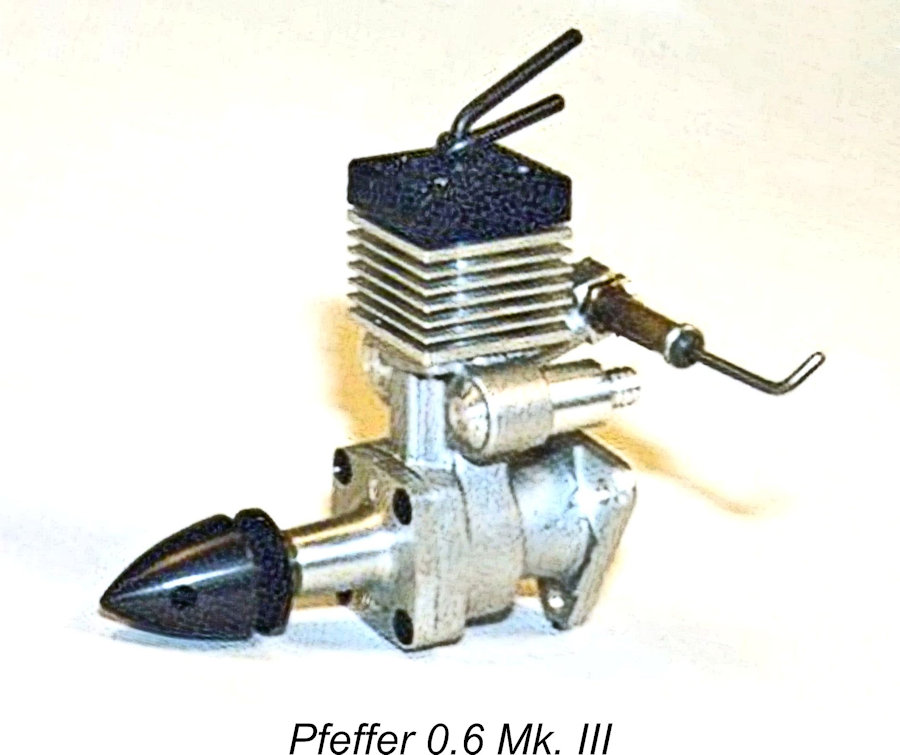 Two operational points to bear in mind. Firstly, the little mufflers do reduce noise slightly without robbing horsepower, and extension tubes can conveniently be added for redirecting exhaust goo. But the mufflers prevent priming through the exhaust. No problem, as one or two drops in the venturi are all that it needs. Really! Finger choking beyond drawing fuel up to the venturi floods the innards, and the engine can’t easily vent a flooded cylinder. The engine then “plays dead” for quite a few subsequent flicks. Keeping that in mind, this one usually starts first flick unless stone cold and is as docile as one would expect.
Two operational points to bear in mind. Firstly, the little mufflers do reduce noise slightly without robbing horsepower, and extension tubes can conveniently be added for redirecting exhaust goo. But the mufflers prevent priming through the exhaust. No problem, as one or two drops in the venturi are all that it needs. Really! Finger choking beyond drawing fuel up to the venturi floods the innards, and the engine can’t easily vent a flooded cylinder. The engine then “plays dead” for quite a few subsequent flicks. Keeping that in mind, this one usually starts first flick unless stone cold and is as docile as one would expect. 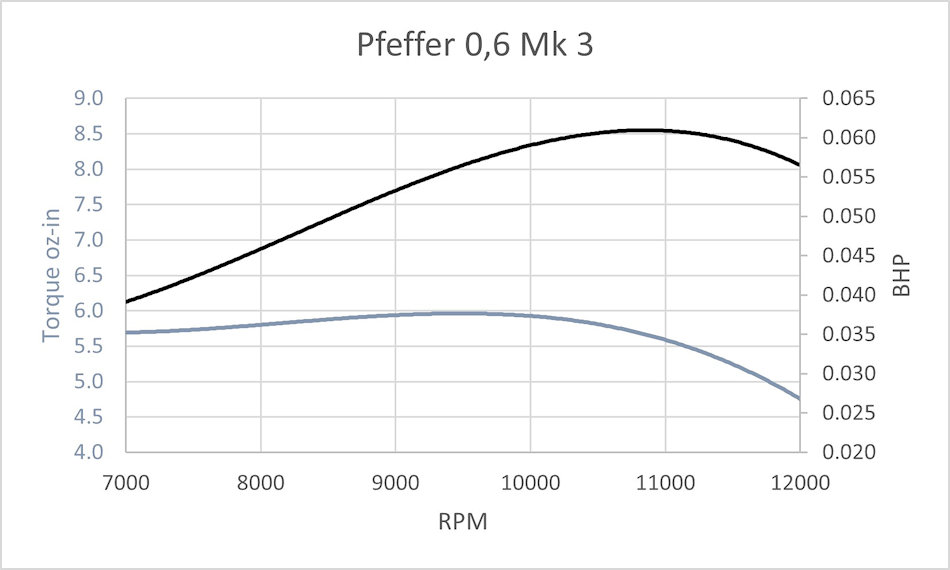
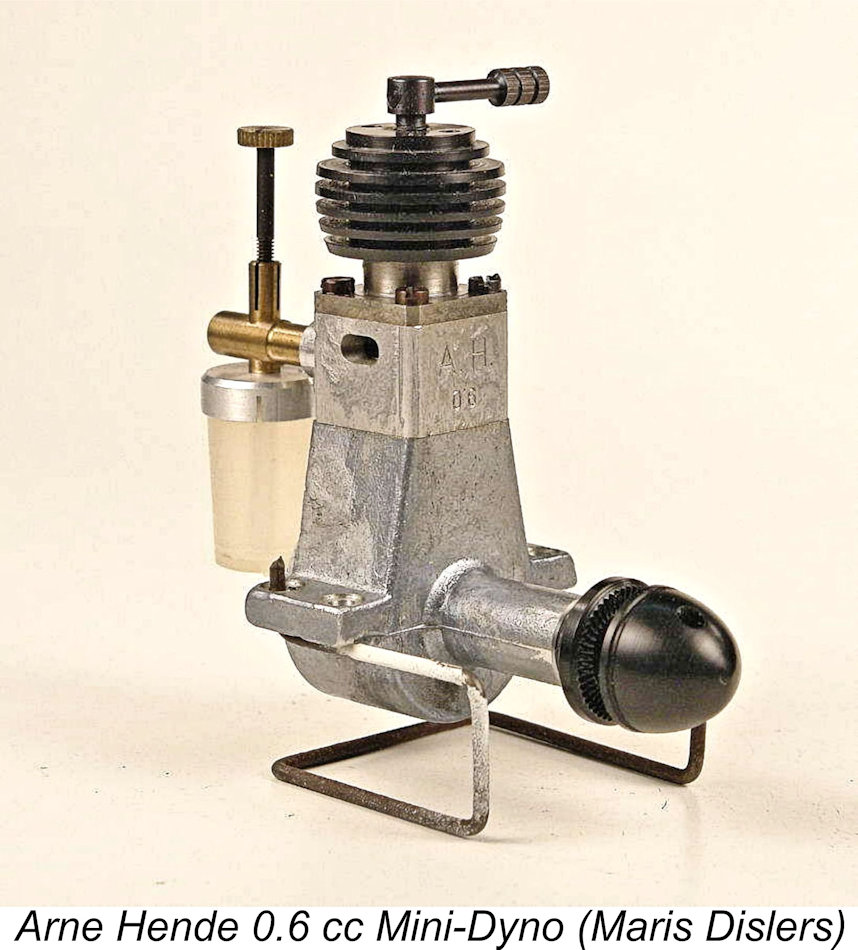 The Arne Hende 0.6 cc mini-DYNO engine goes back to the 1980s and I’m guessing originally came in very authentic form, complete with drain plug and stamped DYNO name and patent message. It appears that Josef Pfeffer was commissioned around 1994 to make clones when the original supplier was no longer available.
The Arne Hende 0.6 cc mini-DYNO engine goes back to the 1980s and I’m guessing originally came in very authentic form, complete with drain plug and stamped DYNO name and patent message. It appears that Josef Pfeffer was commissioned around 1994 to make clones when the original supplier was no longer available.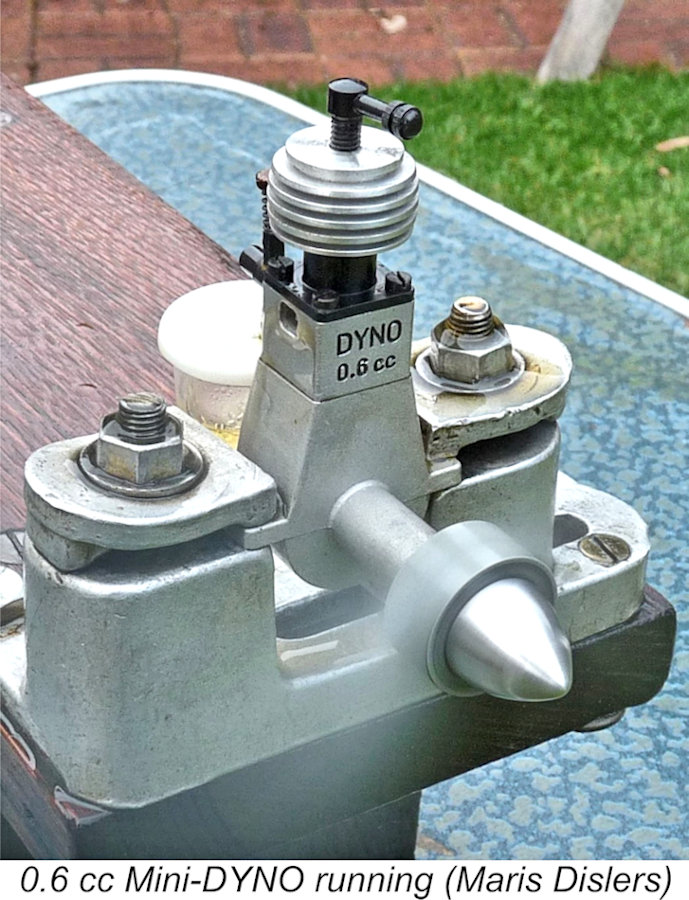 Like the original Klemenz-Schenck DYNO, this one is quite bulky for its swept volume. Disproportionally so in fact, as linear dimensions are around 70% while swept volume is only around 30%. The original 2 cc DYNO developed a little over 0.1 BHP at 6,500 RPM in early German tests. Our mini’s peak power output of 0.0295 BHP, just shy of the predicted .03 BHP based upon the relative displacements, came at around 7,500 RPM from a rather flat power curve.
Like the original Klemenz-Schenck DYNO, this one is quite bulky for its swept volume. Disproportionally so in fact, as linear dimensions are around 70% while swept volume is only around 30%. The original 2 cc DYNO developed a little over 0.1 BHP at 6,500 RPM in early German tests. Our mini’s peak power output of 0.0295 BHP, just shy of the predicted .03 BHP based upon the relative displacements, came at around 7,500 RPM from a rather flat power curve. 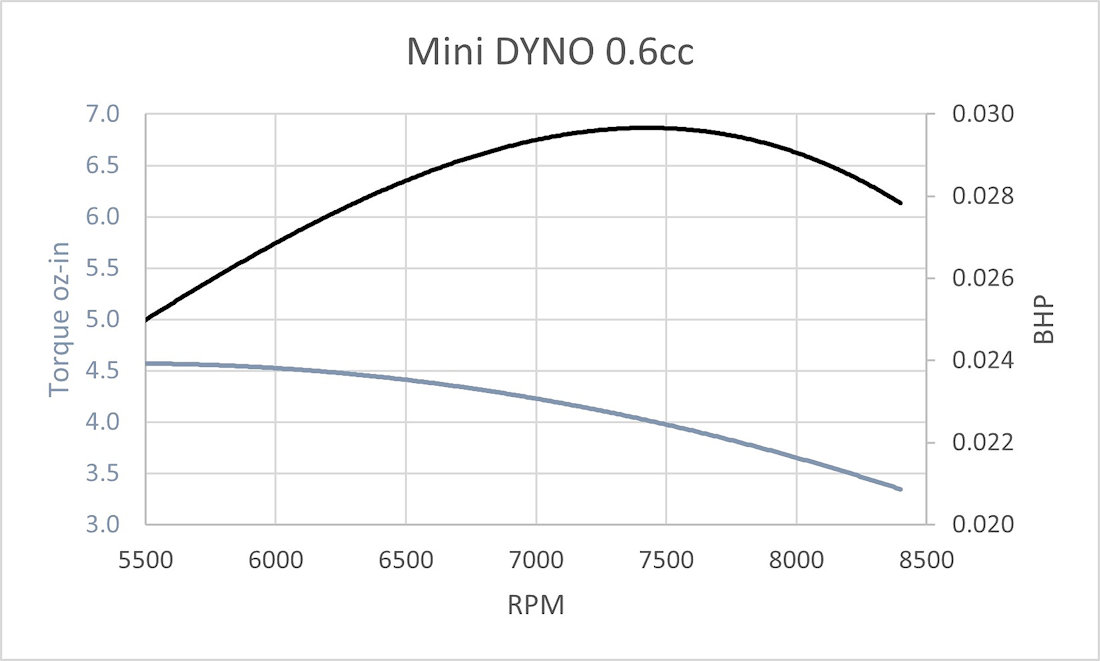
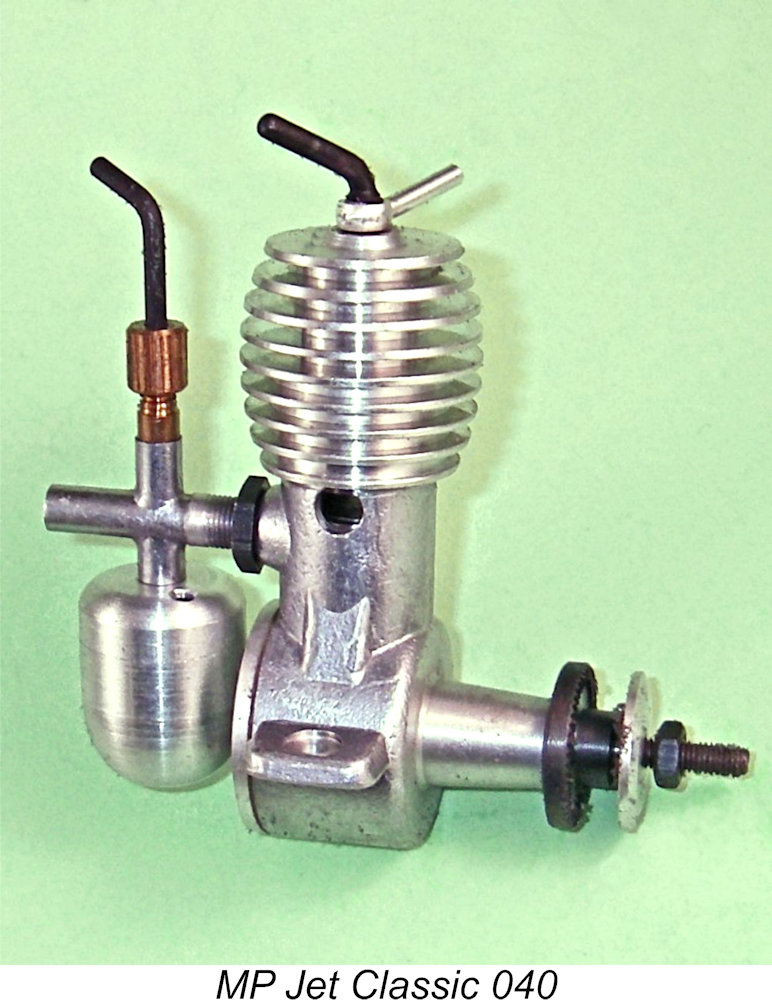 This engine has been reviewed in the modelling press at least four times with varying results, although all reviewers were pleased by its old-school easy starting and good manners. Performance variations were likely due to the piston fit, which is initially markedly tight towards top dead centre in a rather generously tapered cylinder bore.
This engine has been reviewed in the modelling press at least four times with varying results, although all reviewers were pleased by its old-school easy starting and good manners. Performance variations were likely due to the piston fit, which is initially markedly tight towards top dead centre in a rather generously tapered cylinder bore.